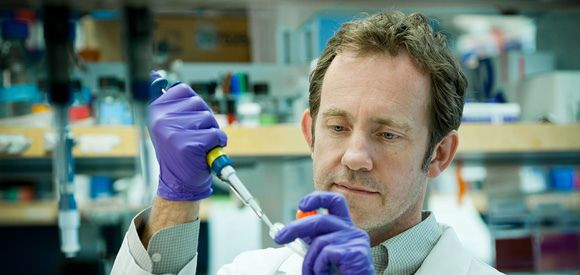Innovative Use Of HIV, Stem Cells Cures Rare Genetic Diseases And Cancer [VIDEO]

A new study has found that the use of the human immunodeficiency virus (HIV) virus, along with blood stem cells, can create a carrier for new genes to replace faulty copies that often cause genetic disorders.
Gene therapy is frequently a useful tool for managing or even curing rare genetic disorders and diseases. Often, scientists can insert a new copy of the gene that has been mutated, or otherwise altered, so that the body of the person with the disease can have the necessary genes it needs to function normally. Genes make proteins and enzymes that are essential to proper function. Genetic diseases are so perilous because a mutated gene affects many other processes that are key to survival.
Genetic disorders are based in the fact that the body has a faulty gene and so cannot make certain proteins and enzymes properly. Proteins and enzymes are critical to our daily functions, as they dictate processes like digestion, thought, mobility, and things we do not even think about like immunity and maintenance of body temperature. One way to fix inherited diseases is by gene therapy. Scientists will go into an animal's DNA, or genes, and insert the missing gene that is causing the animal's disease. Usually, the animal's genetic information is easily altered by the scientist's gene therapy methods, and symptoms of a genetic disorder will go away. However, scientists have had difficulty reproducing these results in human subjects.
Two studies published today in the journal Science highlight the use of a genetically modified HIV virus to correct rare inheirted diseases: metachromatic leukodystrophy (MLD) in ten children with a predisposition toward the disease and Wiskott-Aldrich syndrome (WAS) in six children. The teams also used each patient's own blood stem cells, taken from bone marrow, in an effort to reduce the likelihood that the body would reject treatment. The blood stem cells were used because they have the freedom to go to all parts of the body, and the mutated genes are located in every cell of the body.
Both MLD and WAS are disorders that stem from faulty copies of genes in the body. MLD is caused by the absence of an enzyme that allows for fats to accumulate in appropriate places, like in the brain or in muscles. MLD has been found to cause cognitive deficiencies and impede motor skills, usually leaving patients to die within a few years of MLD's first symptoms. WAS is caused by an absence of enzymes that allow for the immune system to mature appropriately, causing its myriad of symptoms. WAS causes immune deficiencies, anemia, and eczema. And, both have the tendency to occur in children. As there are ways to manage either disorder, disease progression often kills patients within a few short years.
But Doesn't HIV Cause Another Deadly Disease, Acquired Immune Deficiency Syndrome (AIDS)?
In the two studies, the children were not actually infected with bona fide HIV. Viruses cannot survive and proliferate on their own, and so they must infect other cells. When they enter cells, some viruses like the HIV virus will integrate its own genetic information with the host cell's genetic information. Subsequently, HIV will use the host cell's machinery to proliferate its viral genetic information.
The HIV strains used for these studies were genetically modified so that they couldn't hijack a person's host cells.
Researchers also altered the HIV viruses to contain the genes missing — the enzymes that would allow for motor and cognitive function — in the MLD and WAS patients, meaning their immune system cells would develop properly and be able to fight infection. The HIV viruses were made and allowed to infect blood stem cells that researchers had taken from individual patients. The blood cells were then reinjected into patients where they were allowed to replace faulty genes.
Promising Results For Genetic Disorders
For the WAS patients, the researchers found that three of the children responded well to treatment. Six months after treatment, their eczema was gone and did not recur, and their infection also began to decrease. All WAS symptoms had vanished by 20 to 32 months after treatment, and the children's immune systems began to strengthen.
Similarly, the gene therapy for MLD stopped disease progression for an average of 18 months after treatment. This is one of the first times that gene therapy has proven effective by use of both stem cells and viruses. Both teams agree that this was just a trial and that before this becomes common practice, they need to test its efficacy and safety on larger groups of people with genetic disorders for longer periods of time.
Is The Use of HIV A New Trend In Scientific Research?
This is not the first time HIV has been used therapeutically. Something similar has been done in a serious case of leukemia. As explained in the video below, the HIV virus was used to alter immune cells, called T cells, so they would better recognize and kill tumor cells in the body. This is important because normally, T cells cannot recognize cancer, which is how cancer spreads. With this new innovation, the immune cells recognize and kill more than 1,000 cancer cells. Although cancer may still proliferate, the newly injected immune cells will work to kill them when they do.
Fire With Fire | Ross Kauffman from Focus Forward Films on Vimeo.
Sources: Biffi A, Montini E, Lorioli L, et al. Lentiviral Hemaotpeotic Stem Cell Gene Therapy Benefits Metachromatic Leukodystrophy. Science. 2013.
Aitui A, Biasco L, Scaramuzza S, et al. Lentiviral Hemaotpeotic Stem Cell Gene Therapy in Patients With WiskottAldrich Syndrome. Science. 2013.



























